10 Most Famous Mountain Paintings
Landscape and nature paintings have been some of the almost popular genres for artists throughout human history. Information technology'southward clear that mountains ofttimes serve every bit a symbol for a multifariousness of things in art such as a powerful obstruction, continuity, God, and many other things.
Artists from all across the world have often used mountains in their works to emphasize a sense of power from both the divine and nature.
Mountains usually dominate the landscape and some artists have painted entire series of works dedicated to a unmarried mountain or the area around certain mountains.
Their snow-covered peaks provide a stark contrast to the lush green valleys and lowlands that prevarication beneath mountains.
In the terminal few centuries, mountain landscapes have become quite pop with artists placing special consideration on what these enormous landmasses symbolize for themselves and the viewer.
Famous Mountain Paintings
In this commodity, we will examine some of the most famous mountain paintings always created and have a closer await at the motivations each creative person had in producing these works.
one. Looking Downwardly the Yosemite Valley – Albert Bierstadt
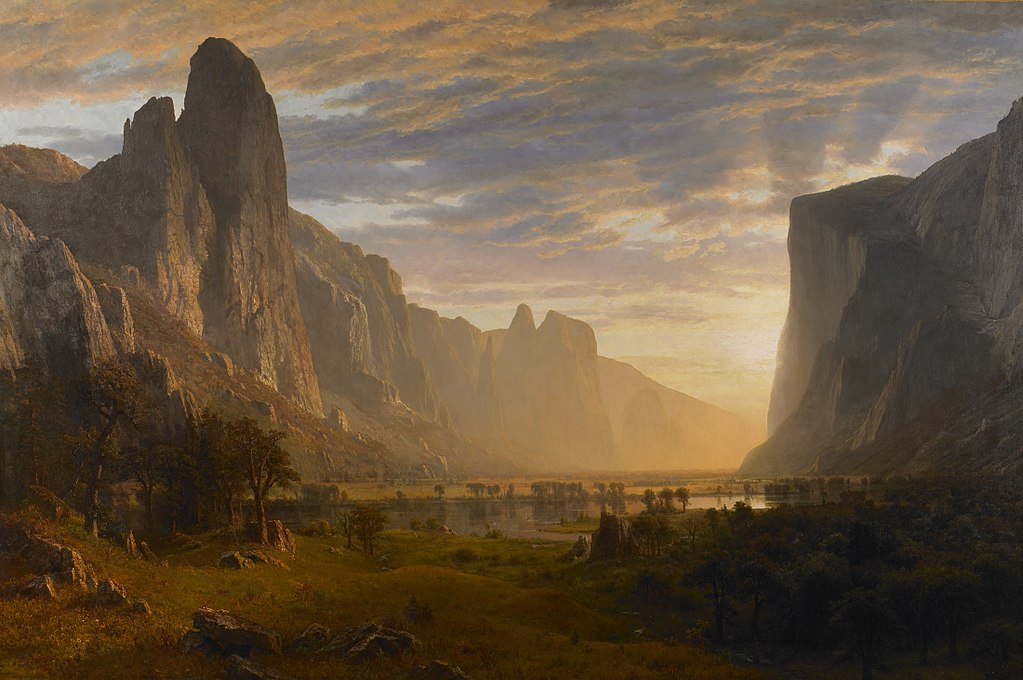
Albert Bierstadt was one of the most brilliant landscape artists to always live. During his career, he produced a number of works pertaining to some of the most strikingly beautiful landscapes in the United States.
Many of his all-time paintings focus on Yosemite Valley and the mountain's surrounding the famous space which was designated as a National Park in 1890.
Bierstadt'south 1865 painting highlighted i of the nearly scenic scenes from the Yosemite area, which was the valley itself.
He was a celebrated landscape artist and had already amassed quite a post-obit amongst art enthusiasts in the United states due to his powerfully realistic depictions of scenes such as this.
The painting is titled Looking Down the Yosemite Valley. It is said by art historians that Bierstadt ventured to the valley every afternoon for many weeks or months in his efforts to capture the perfect display of light equally it shimmered and reflected off the walls of the mountains on either side of the valley.
2. The Wanderer higher up the Sea of Fog – Caspar David Friedrich
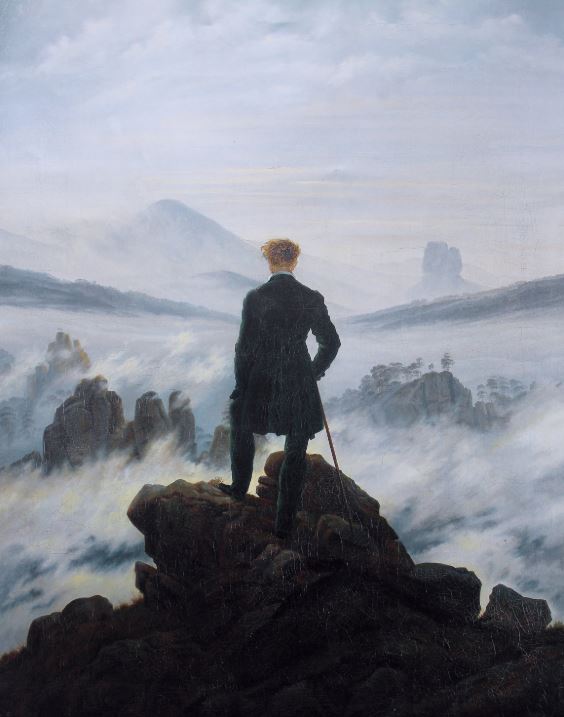
Caspar David Friedrich was a German painter who was very much stricken with what is known in his home country as wanderlust, or the insatiable desire to travel the world and see all its beauty.
He spent a great deal of time travelling to various locations throughout the globe to behold the natural beauty independent in them.
Friedrich is recognized every bit one of the most prolific painters from the Romanticism era and his works were characteristic of the different elements that brought fame to so many of his paintings.
Undoubtedly, his nigh famous mount painting is titled The Wanderer higher up the Sea of Fog. It was completed in 1818 and depicts a single man continuing on a rocky outcrop overlooking a sweeping mount range that is blanketed in fog.
Friedrich'south casual brush strokes and intense detail in the foreground seem to create the sense that the man is continuing with his face to the wind as the fog is kickoff to be blown away.
The work is symbolic of Friedrich'southward own fascination with such landscapes and many art critics believe the man in the painting is a delineation of himself.
3. The Heart of the Andes – Frederic Edwin Church
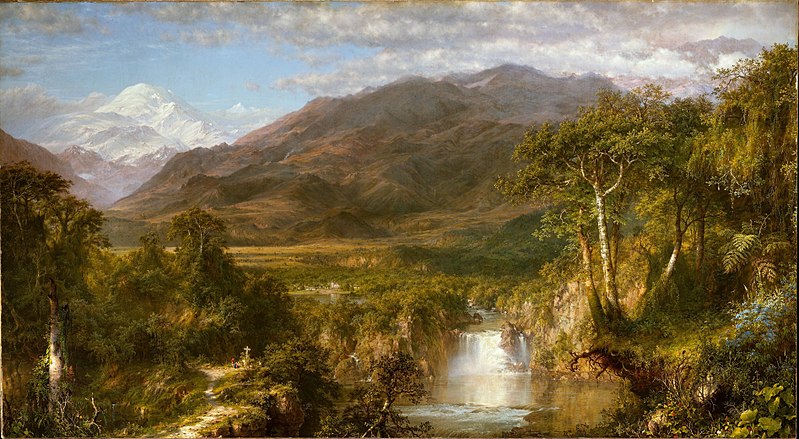
Some other i of the greatest mountain paintings is a work that seems to be almost cinematic in nature as it features a wide view of a lush valley with an imposing mountain in the distance.
Frederic Edwin Church was a well-known American mural painter who is remembered as a pivotal member of the Hudson River School, which included a number of distinguished mural artists from the Us.
One of his nigh notable artworks is titled The Heart of the Andes. Information technology was painted in 1859 and depicts a scene from the Andes mountain range in Southward America.
During this fourth dimension menstruation, various American artists ventured to the South American continent to capture the beauty of the mountain ranges and other areas.
In this work, the viewer sees a cascading waterfall in the foreground followed by the valley that stretches all the mode upwardly to the edge of the mountain range.
Also Read: Waterfall Paintings
An even taller, more domineering mountain is seen in the left side of the background with its snow-covered ridges and peaks.
4. South Wind, Clear Dawn (Red Fuji) – Katsushika Hokusai
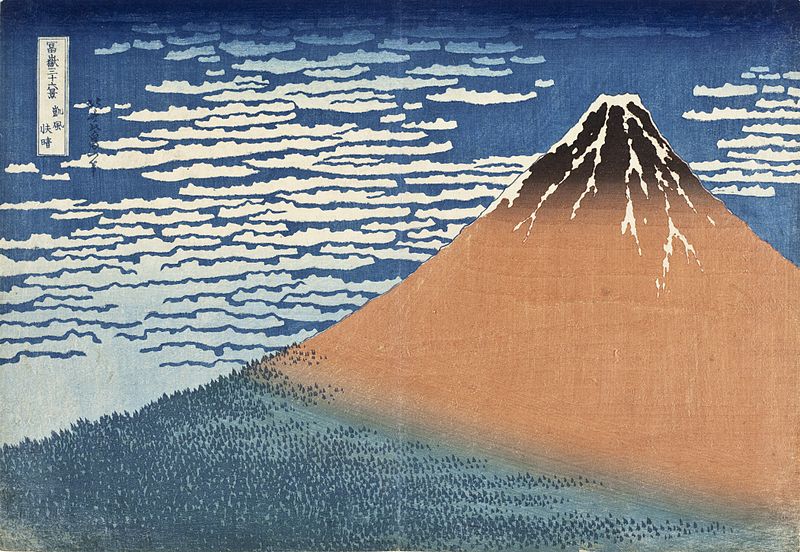
Katsushika Hokusai is 1 of the most celebrated artists from Japanese history. Many of his works focused on natural settings such equally mountains or oceans with a few blending both together.
He painted in a very distinct, colorful style that often highlighted the dissimilarity between certain elements such as a mountain and its lower valley.
One of his most notable paintings is titled South Wind, Clear Dawn (Cerise Fuji). The piece of work was part of a 36-painting serial that focused on the many different depictions of Nippon's legendary Mountain Fuji.
As well Read: Japanese Artists
Completed in 1832, Hokusai's works were still not immune to exist sold outside of his native Nihon, but many of his paintings and copies of them would find their way into the hands of American and European art collectors.
This painting depicts the unique red coloration that Mountain Fuji is known to have in the right weather condition at dawn. Hokusai'due south inclusion of a bright blue heaven next to the mount's jutting acme further emphasizes the degree to which Mount Fuji seems to boss the surrounding landscape.
5. Mont Sainte Victoire (Courtauld) – Paul Cézanne
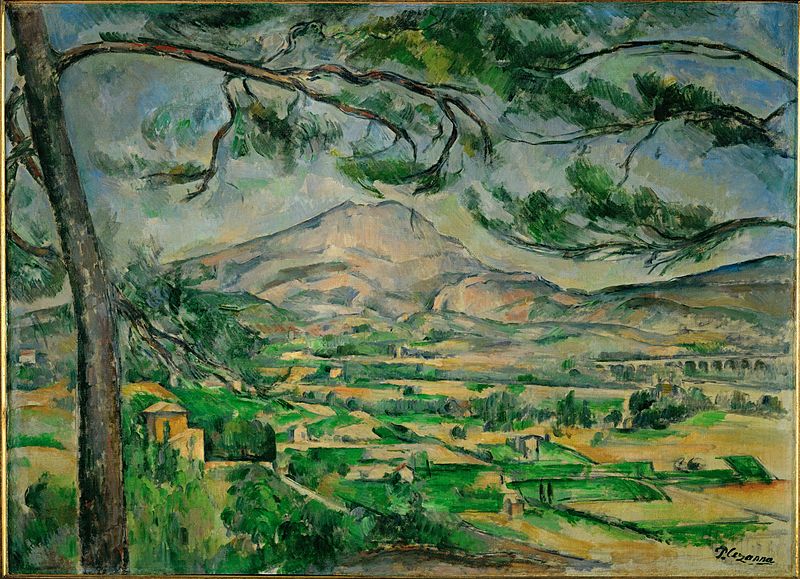
Paul Cézanne is remembered equally i of the most iconic French painters in history and one that truly shaped the evolution of art in the Mail-Impressionist movement and onward.
He painted many works pertaining to diverse landscapes and mountains, but none drew as much of his attention every bit Mont Sainte Victoire, which is a massive limestone ridge located in the south of France.
Cézanne really devoted dozens of paintings to this one mount and is known to have painted a multifariousness of different angles and depictions of this famous mural. The most notable of these works is just titled Mont Sainte Victoire (Courtauld).
Completed in 1887, this painting contrasts the bright and playful colors of the fields in the valley below with the mountain'southward bleak gradient.
vi. The Golden 60 minutes – Thomas Moran
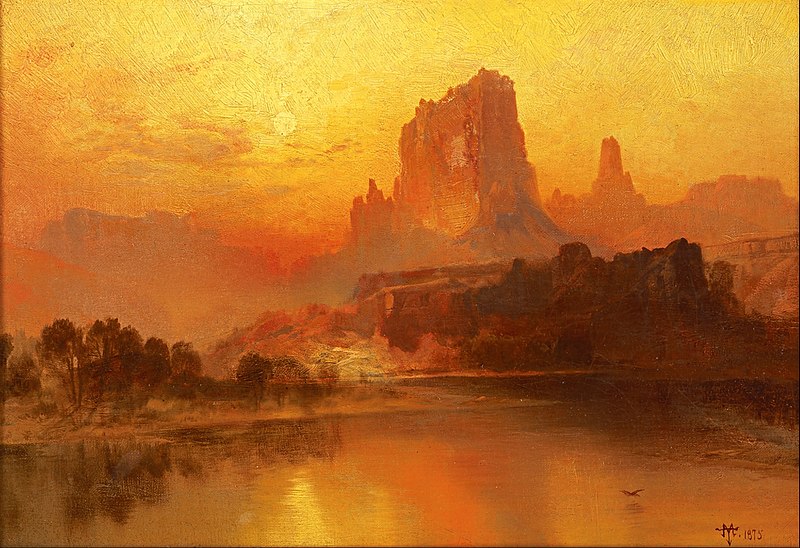
Many artists chose to portray the mountains that they painted in dissimilarity to the dawn or setting dominicus equally this provided an exceptional scene of both the sunday's incredible beauty combined with that of the rocky peaks of the mountains.
Ane mountain painting in detail that includes intense levels of sunlight was washed by Thomas Moran, an American painter and printmaker who worked during the belatedly 19th and early 20th centuries.
The painting depicts the incredible mountains that seem to burst along from the ground next to the Green River in southwestern Wyoming.
This 1875 work is nearly unmatched in the artist'south power to alloy sunrise and mountain landscape together into one scenic piece of work.
7. The Voyage of Life, Childhood – Thomas Cole
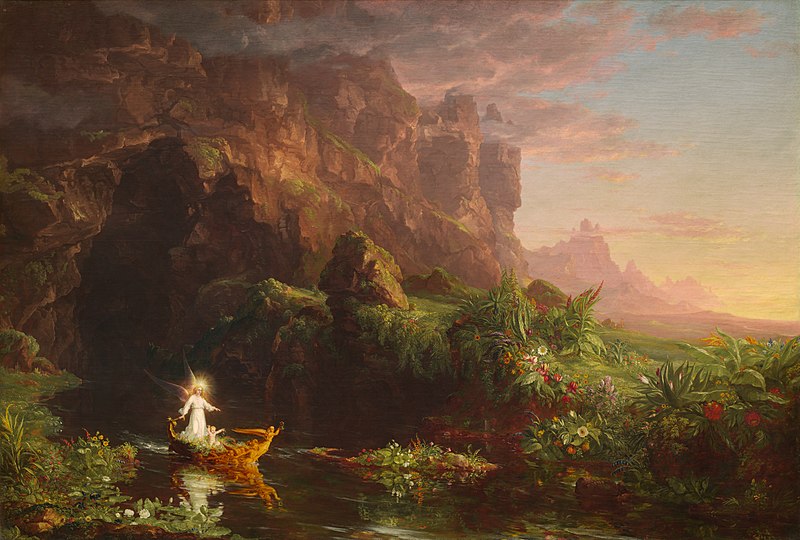
Thomas Cole is often regarded as the father of American mural painting as he founded the Hudson River School in the early on 1800's.
Also Read: River Paintings
He regularly focused on landscapes that included mountain ranges as they added to the variety of landscape that added to the mystique and wonder that many in the United States and Europe had never laid eyes on earlier.
One of his near famous works was a serial titled The Voyage of Life, Childhood. These paintings were washed betwixt 1844 and 1848 and feature four distinct paintings that each represent a different stage in life.
Each of the majestic landscapes features a boy who grows into an old man over the course of the works who is guarded by an angelic figure.
eight. The Rocky Mountains – Albert Bierstadt
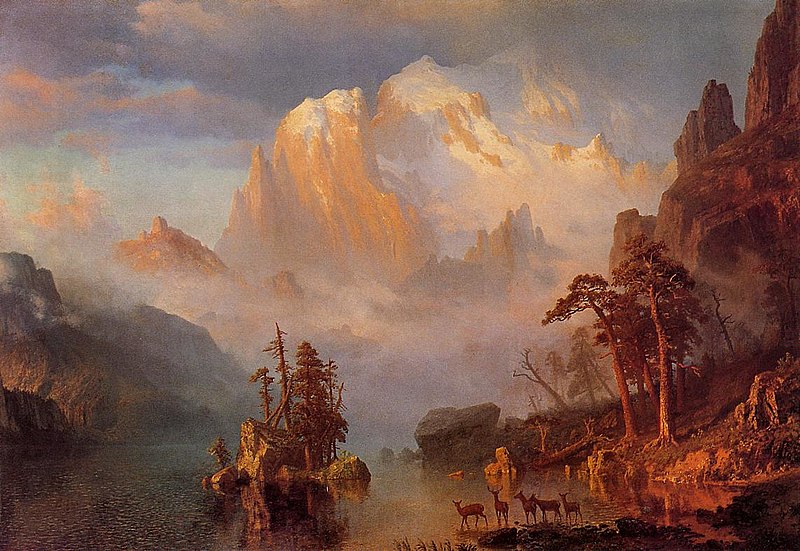
Another ane of Albert Bierstadt'south mountain paintings involves the illustrious peaks of the Rocky Mountains that span across much of the western United States.
During the early to mid-19th century, many Americans living in the eastern one-half of the land had not yet laid eyes on this majestic mountain range that stretches for thousands of miles.
Many had only read about it in books until they were able to view works by artists such as Bierstadt, who had traveled to this part of the state.
He would capture much of the wonder and beauty associated with the Rockies in one work known as The Rocky Mountains.
Painted in 1863, Bierstadt'south work drew widespread acclaim and elicited even more than fascination from the American public about what kind of country lay beyond the Mississippi River.
ix. Scene from 'The Terminal of the Mohicans': Cora Kneeling at the Anxiety of Tanemund – Thomas Cole
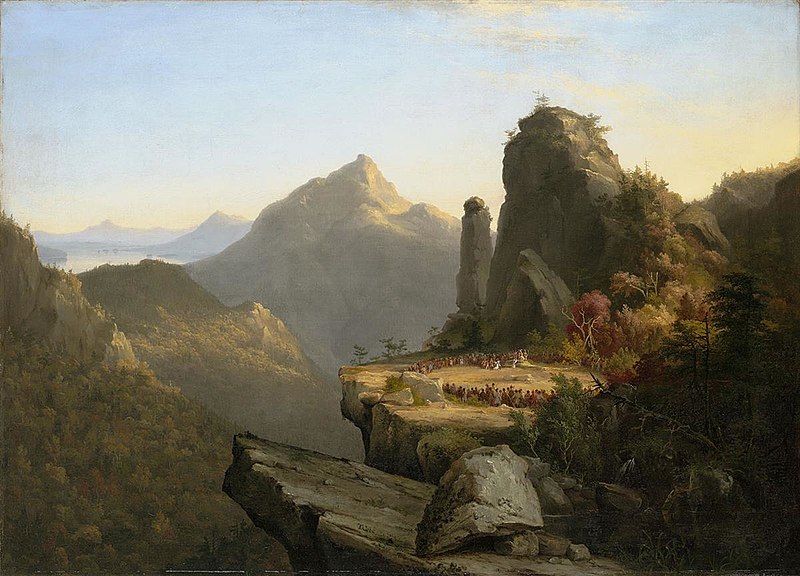
By the early on 1800's it was becoming apparent that many of the Native American peoples and tribes who had inhabited the state in what became the United States were quickly being pushed out—even to the bespeak of extinction.
A famous novel by James Fenimore Cooper told the story of the Mohican tribe as information technology was engaged with a brutal struggle with settlers and eventually driven off their homeland. The book was an instant classic and remains and so fifty-fifty today.
One of the most famous american paintings always created is based on this story and captures one of the most striking scenes from the volume when the tribe gathers at the pes of White Mountain in New Hampshire.
Thomas Cole rendered this cute depiction of this scene in a painting titled Scene from 'The Concluding of the Mohicans': Cora Kneeling at the Feet of Tanemund, which was completed in 1827.
The work features the tribe gathered in a circle on the edge of a cliff at an overlook near White Mount. This painting besides utilizes subtle differences in light and nighttime as the setting sun can be seen sweeping across the landscape.
10. Pass at Glencoe Scotland – Thomas Moran
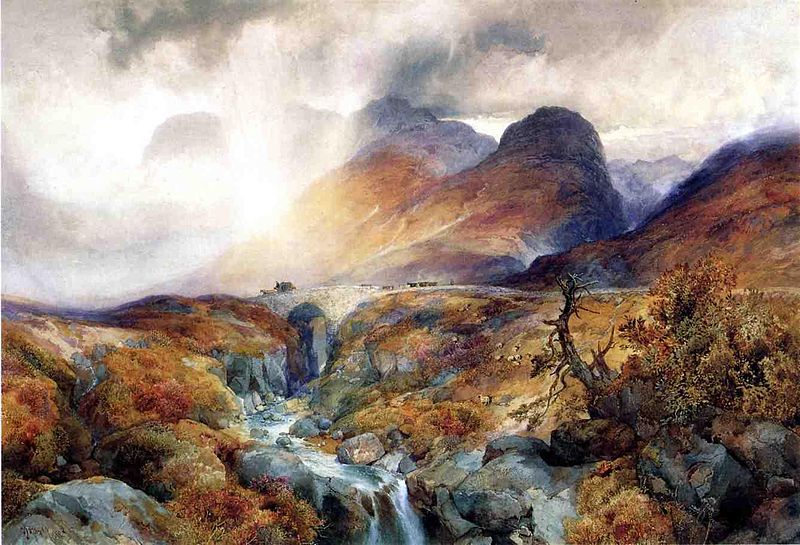
Some other i of Thomas Moran's corking masterpieces was created in 1882.
He was known to paint various landscapes and later in his career would focus on thoses which featured elements of rain and other weather condition events that changed the color and contrast of the mountains and other elements in his paintings.
One such work was focused on a famous mountain pass in the center of Scotland. This painting is titled Pass at Glencoe Scotland and features an all-too-common rainstorm blowing across the distant mountains while a calm stream babbles toward the viewer in the foreground.
The colors of the painting combined with the clouds and weather create a memorable scene that is vivid plenty for the viewer to most feel the absurd rain moving toward them.
maddoxidentradmus.blogspot.com
Source: https://www.artst.org/mountain-paintings/
0 Response to "10 Most Famous Mountain Paintings"
Post a Comment